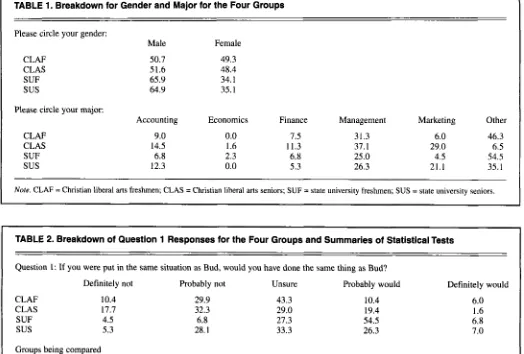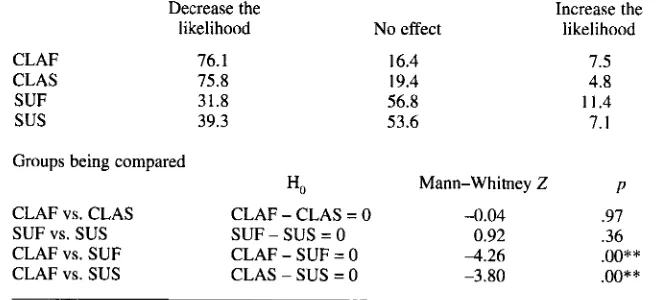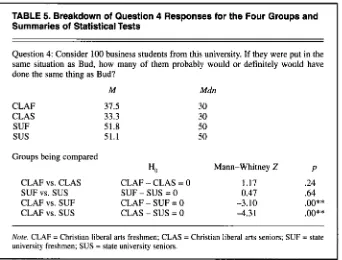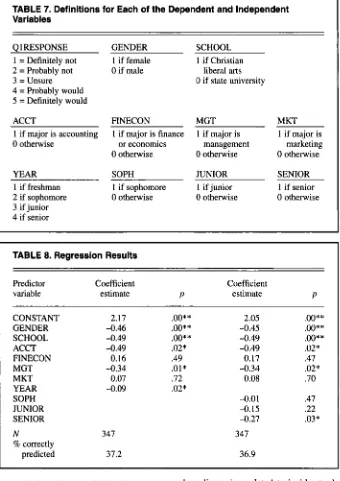Full Terms & Conditions of access and use can be found at
http://www.tandfonline.com/action/journalInformation?journalCode=vjeb20
Download by: [Universitas Maritim Raja Ali Haji] Date: 12 January 2016, At: 23:45
Journal of Education for Business
ISSN: 0883-2323 (Print) 1940-3356 (Online) Journal homepage: http://www.tandfonline.com/loi/vjeb20
Does the Study of Business Reduce the Likelihood
of Committing Insider Trading?
Kent T. Saunders
To cite this article: Kent T. Saunders (2002) Does the Study of Business Reduce the Likelihood of Committing Insider Trading?, Journal of Education for Business, 78:2, 75-80, DOI:
10.1080/08832320209599701
To link to this article: http://dx.doi.org/10.1080/08832320209599701
Published online: 31 Mar 2010.
Submit your article to this journal
Article views: 9
Does the Study of Business
Reduce the Likelihood of
Committing Insider Trading?
KENTT. SAUNDERS
zyxwvutsrqponmlkjihgfedcbaZYXWVUTSRQPONMLKJIHGFEDCBA
Anderson University Anderson, Indiana
he Enron disaster of 2002 has
T
caused many to consider the ethics of business executives. One unethical practice that receives prominent media attention is insider trading. In this study, I investigated whether the study of busi- ness reduces the likelihood of commit- ting insider trading. Dyl (1991) de- scribed two methods of using the 1987Oliver Stone film
zyxwvutsrqponmlkjihgfedcbaZYXWVUTSRQPONMLKJIHGFEDCBA
Wall Street as a casestudy in ethics and provided a list of questions to ask at different stopping points during the film. In the present study, students completed a survey after watching a 15-minute clip that begins approximately 7 minutes into the film
Wall Street.‘
The film clip shows the film’s main character, Bud Fox, under financial duress. Bud comments to a colleague, “I’m tapped out. American Express has got a hit-man looking for me.” In a con- versation with his father, Bud learns some potentially valuable inside infor- mation related to Bluestar Airlines, the company his father works for. Bud’s father says that the “FAA is going to
rule.
zyxwvutsrqponmlkjihgfedcbaZYXWVUTSRQPONMLKJIHGFEDCBA
.
. .
This gets us out from undersuspension. We can go for the new routes to Pittsburgh and Boston. We’re gonna compete with the big guys.” Bud recognizes this as valuable information and begins to process what to do with this new knowledge. Bud asks his father, “Are you sure about this thing? The FAA announcement?’ His father notices a “mischievous look” in Bud’s
ABSTRACT. In this study, 347 stu- dents at two Christian liberal arts schools and a state university complet- ed a survey after watching a clip from
the 1987 film
zyxwvutsrqponmlkjihgfedcbaZYXWVUTSRQPONMLKJIHGFEDCBA
Wall Street. The survey was given to 347 students. Seniorswere less likely to respond that they would commit insider trading than were freshmen, and students attending the Christian liberal arts schools, com- pared with students at the state univer- sity, were less likely to respond that they would commit insider trading.
eye. An opportunity arises the next day for Bud to use the inside information to secure a business relationship with the film character Gordon Gekko, a Wall Street tycoon. Bud tells Gekko that the airline “just got a favorable ruling on a lawsuit that even the plaintiffs don’t know about.
. . .
There is only a small float out there. You should grab it. It’s good for a 5-point pop.” The film clip concludes when Gekko calls Bud later in the day and places an order for 20.000 shares of Bluestar Airline stock.Survey and Research Hypotheses
The four-question survey was given to 347 students at Anderson University and Ball State University in Indiana and Greenville College in Illinois during the period from December 2001 to February 2002. Anderson University and Green- ville College are both Christian liberal arts schools. For univariate comparisons,
the 347 student responses were broken down into four groups: (a) Christian lib- eral arts freshmen (CLAF), comprising 62 Anderson University and Greenville College freshmen in introductory busi- ness courses; (b) Christian liberal arts seniors (CLAS), comprising 67 Ander- son University and Greenville College seniors in upper-level business courses;
state university freshmen
zyxwvutsrqponmlkjihgfedcbaZYXWVUTSRQPONMLKJIHGFEDCBA
(SUF), com-prising 44 Ball State University fresh- men in introductory business courses; and state university seniors (SUS), com- prising 57 Ball State University seniors in upper-level business courses. Of the 347 students, 117 did not fall into any of the four categories.
The first research hypothesis in this study was that the academic study of business (which includes finance, busi- ness law, etc.) would reduce the likeli- hood of committing insider trading- that is, CLAS and SUS would be less likely than CLAF and SUF to do the same thing as Bud. My second research hypothesis was that there would be a dif- ference in the response patterns between the two types of schools (Christian liber- al arts and state)-that is, CLAF and CLAS would respond differently from SUF and SUS, respectively.
Survey Responses and Univariate Analysis
In the survey, students circled their gender, year in school, and major. The
NovembedDecember 2002 75
breakdown for gender and major in the four groups is listed in Table 1. There was a noticeably higher percentage of male students in SUF and SUS than in CLAF and CLAS, respectively.
The survey included questions related to how likely they and their peers would be to behave similarly to Bud. The first question was “If you were put in the same situation as Bud, would you have
done the same thing as Bud?’
zyxwvutsrqponmlkjihgfedcbaZYXWVUTSRQPONMLKJIHGFEDCBA
I used theMann-Whitney test to compare the response patterns between the groups. In Table 2, I provide the breakdown of responses for the four groups and sum- maries of the statistical tests.
In response to the first question, 50.0% of CLAS, compared with 40.3%
of CLAF, selected “definitely not” or “probably not.” For Question 1, howev- er, I did not find a significant difference in the distribution between CLAS and CLAF. There was a significant differ- ence in the distribution between SUS and SUE Slightly over one third of the seniors at the state university, compared with 11.3% of state university fresh- men, selected “definitely not” or “prob- ably not.” These two results lend some support to the research hypothesis that the study of business reduces the likeli- hood of committing insider trading.
I used a two-tailed test with a 5% level of significance to compare the response patterns between types of school. There were significant differ-
ences in the distribution between CLAF and SUF and in the distribution between
CLAS and SUS. Students at the Chnst- ian liberal arts schools, compared with students at the state school, were less likely to respond that they would do the same thing as Bud.
The second question in the survey was “Consider typical business students from this university. If they were put in the same situation as Bud, would they have done the same thing as Bud?’ In Table 3, I provide the breakdown of re-
sponses for the four groups and sum- maries of the statistical tests. For Ques- tion 2, there was no significant dif- ference in the distributions between
CLAF and CLAS or between SUF and
zyxwvutsrqponmlkjihgfedcbaZYXWVUTSRQPONMLKJIHGFEDCBA
TABLE 1. Breakdown for Gender and Major for the Four Groups Please circle your gender:
Male Female
zyxwvutsrqponmlkjihgfedcbaZYXWVUTSRQPONMLKJIHGFEDCBA
r
CLAF CLAS SUF
sus
Please circle your major: CLAF
CLAS SUF
sus
50.7 49.3 51.6 48.4 65.9 34.1 64.9 35.1
Accounting Economics Finance h -magement Marketing Other 9.0 0.0 7.5 31.3 6.0 46.3 14.5 1.6 11.3 37.1 29.0 6.5 6.8 2.3 6.8 25.0 4.5 54.5
12.3 0.0 5.3 26.3 21.1 35.1
zyxwvutsrqponmlkjihgfedcbaZYXWVUTSRQPONMLKJIHGFEDCBA
[image:3.612.46.570.286.640.2]Note. CLAF = Christian liberal
zyxwvutsrqponmlkjihgfedcbaZYXWVUTSRQPONMLKJIHGFEDCBA
arts freshmen; CLAS = Christian liberal arts seniors; SUF = state university freshmen; SUS = state university seniors. TABLE 2. Breakdown of Question 1 Responses for the Four Groups and Summaries of Statistical TestsQuestion I: If you were put in the same situation as Bud, would you have done the same thing as Bud?
Definitely not Probably not Unsure Probably would Definitely would CLAF 10.4
CLAS 17.7 SUF 4.5
sus
5.329.9 32.3 6.8 28.1
43.3 29.0 27.3 33.3
10.4 19.4 54.5 26.3
6.0 1.6 6.8 7.0 Groups being compared
H” Mann-Whitney Z P
CLAF vs. CLAS CLAF - CLAS
zyxwvutsrqponmlkjihgfedcbaZYXWVUTSRQPONMLKJIHGFEDCBA
I 0 0.85 .19SUF vs. SUS SUF - SUS I 0 2.14
.oo**
CLAF vs. SUF CLAF - SUF = 0 4 . 4 4.oo**
CLAF vs. SUS CLAS - SUS = 0 -2.30 .01*Note. CLAF = Christian liberal arts freshmen; CLAS = Christian liberal arts seniors; SUF = state university freshmen; SUS = state university seniors.
* p < .05. **p < .01.
76 Journal
zyxwvutsrqponmlkjihgfedcbaZYXWVUTSRQPONMLKJIHGFEDCBA
of Education for Business [image:3.612.48.567.472.703.2]TABLE 3. Breakdown of Question 2 Responses for the Four Groups and Summaries of Statistical Tests
zyxwvutsrqponmlkjihgfedcbaZYXWVUTSRQPONMLKJIHGFEDCBA
~ zyxwvutsrqponmlkjihgfedcbaZYXWVUTSRQPONMLKJIHGFEDCBA
Question 2: Consider typical business students from this university. If they were put in the same situation as Bud,
zyxwvutsrqponmlkjihgfedcbaZYXWVUTSRQPONMLKJIHGFEDCBA
would they have done the same thing as Bud?Definitely not Probably not Unsure Probably would Definitely would CLAF
CLAS SUF
sus
6.0 4.8 2.3 0.0
38.8 54.8 11.4 17.5
40.3 30.6 40.9 35.1
Groups being compared
zyxwvutsrqponmlkjihgfedcbaZYXWVUTSRQPONMLKJIHGFEDCBA
“0 Mann-Whitney Z
zyxwvutsrqponmlkjihgfedcbaZYXWVUTSRQPONMLKJIHGFEDCBA
PCLAF vs. CLAS CLAF - CLAS = 0 1.52 .13 SUF vs. SUS SUF - SUS = 0 0.19 .85 CLAF vs. SUF CLAF
-
SUF = 0 -4.02.oo**
CLAF vs. SUS CLAS - SUS = 0 -5.43.oo**
13.4 9.7 43.2 40.4
1.5 0.0 2.3
7.0
zyxwvutsrqponmlkjihgfedcbaZYXWVUTSRQPONMLKJIHGFEDCBA
Note. CLAF = Christian liberal arts freshmen: CLAS = Christian liberal
zyxwvutsrqponmlkjihgfedcbaZYXWVUTSRQPONMLKJIHGFEDCBA
arts seniors: SUF = state university freshmen; SUS = state university seniors.**p < .01.
SUS. There was a significant difference in the distribution between CLAF and SUF and between CLAS and SUS. Stu-
dents at the Christian liberal arts schools, compared with students at the state university, were less likely to respond that their peers would do the same thing as Bud.
The third question was “Consider typical business students from this uni- versity. If they were put in the same sit- uation as Bud, how would their business education at this university affect the likelihood that they would have done the same thing as Bud?’ Table 4 con- tains the breakdown of responses for the four groups and summaries of the statis- tical tests. For Question 3, there was no
significant difference in the distribution between CLAF and CLAS or between SUF and SUS. There was a significant difference in the distribution between CLAF and SUF and between CLAS and
SUS. Students at the Christian liberal
arts schools, compared with students at the state university, were more likely to respond that business education would decrease the typical students’ likelihood of doing the same thing as Bud.
Students filled in the blank with a number for the fourth question: “Con- sider 100 business students from this university. If they were put in the same situation as Bud, how many of them probably would or definitely would have done the same thing as Bud?’ In
[image:4.612.48.564.101.247.2]Table
zyxwvutsrqponmlkjihgfedcbaZYXWVUTSRQPONMLKJIHGFEDCBA
5 , I provide the breakdown ofTABLE 4. Breakdown of Question 3 Responses for the Four Groups and Summaries of Statistical Tests
Question 3: Consider typical business students from this university. If they were put in the same situation as Bud, how would their business education at this university affect the likelihood that they would have done the same thing as Bud?
Decrease the Increase the likelihood No effect likelihood CLAF
CLAS SUF
sus
76.1 75.8 31.8 39.3
16.4 19.4 56.8 53.6
7.5 4.8 11.4 7.1 Groups being compared
*o Mann-Whitney
zyxwvutsrqponmlkjihgfedcbaZYXWVUTSRQPONMLKJIHGFEDCBA
2 PCLAF vs. CLAS CLAF - CLAS = 0 -0.04 .97 SUF vs. SUS SUF - SUS = 0 0.92 .36
CLAF vs. SUF CLAF - SUF = 0 4 . 2 6
.oo**
CLAF vs. SUS CLAS - SUS = 0 -3.80 .00**Note. CLAF = Christian liberal arts freshmen; CLAS = Christian liberal arts seniors: SUF = state university freshmen: SUS = state university seniors.
responses for the four groups and sum- maries of the statistical tests. For Ques- tion 4, there was no significant differ- ence in the distribution between CLAF and CLAS or between SUF and SUS. There was a significant difference in the distributions between CLAF and SUF and between CLAS and SUS. Students at the Christian liberal arts schools, compared with students at the state uni- versity, were less likely to respond that their colleagues would do the same thing as Bud.
For students at the Christian liberal arts schools, the actual percentage who selected “probably would or definitely would” was 22%, which would be 22 of
100. For students at the state school, the actual percentage who selected “proba- bly would or definitely would” was 46.8%. which would be 46.8 out of 100.
Self-Enhancing Bias
Manley, Russell, and Buckley (2001) found that students perceived them-
NovernbedDecember 2002 77
[image:4.612.232.564.382.532.2]selves as less likely than the average person to engage in unethical behavior. A similar response pattern emerged in the present data. Students who respond- ed to Question 1 that they “definitely would” or “probably would have done the same thing as Bud,” compared with those who responded “definitely not,” “probably not,” or “unsure,” assumed that more of their colleagues would do
the same. In Table
zyxwvutsrqponmlkjihgfedcbaZYXWVUTSRQPONMLKJIHGFEDCBA
6, I provide thebreakdown of mean responses to Ques- tion 4 by each of the five responses to Question 1 for all Christian liberal arts students (CLA), all state university stu- dents (SU), and the entire sample (ALL).
The following is an example from Table 6. For the entire sample, students who selected “definitely would” as a response to Question 1 assumed that 59
out of 100 of their colleagues would respond “probably would or definitely would” to Question 1. In contrast, stu- dents who selected “definitely not” as a response to Question 1 assumed that 27.8 out of 100 of their colleagues would respond “probably would or def-
initely would” to Question 1.
zyxwvutsrqponmlkjihgfedcbaZYXWVUTSRQPONMLKJIHGFEDCBA
Multivariate Analysis
I conducted multiple regressions to control for the simultaneous effects of gender, school, major, and year in school on the response to Question 1. I conducted ordered probit regressions because of the discrete ordinal nature of the dependent variable. I used the entire sample of 347 student responses in this multivariate analysis. I ran two regres- sions based on the following equations:
TABLE 5. Breakdown of Question 4 Responses for the Four Groups and Summaries of Statistical Tests
Question
zyxwvutsrqponmlkjihgfedcbaZYXWVUTSRQPONMLKJIHGFEDCBA
4: Consider 100 business students from this university. If they were put in the same situation as Bud, how many of them probably would or definitely would havedone the same thing as Bud?
zyxwvutsrqponmlkjihgfedcbaZYXWVUTSRQPONMLKJIHGFEDCBA
M Mdn
CLAF CLAS SUF
sus
37.5 33.3 51.8 51.1
30 30 50 50
Groups being compared
Ho Mann-Whitney
zyxwvutsrqponmlkjihgfedcbaZYXWVUTSRQPONMLKJIHGFEDCBA
Z P CLAF vs. CLAS CLAF - CLAS = 0 1.17 .24SUF vs. SUS SUF - SUS = 0 0.47 .64
CLAF vs. SUF CLAF - SUF = 0 -3.10
.oo**
CLAF vs.
sus
CLAS - SUS = 0 -4.31.oo**
Note. CLAF = Christian liberal arts freshmen; CLAS = Christian liberal arts seniors; SUF = state university freshmen; SUS = state university seniors.
Qlresponse = F(GENDER, SCHOOL,
ACCT, FINECON, MGT, MKT,
YEAR).
zyxwvutsrqponmlkjihgfedcbaZYXWVUTSRQPONMLKJIHGFEDCBA
Qlresponse = F(GENDER, SCHOOL, ACCT, FINECON, MGT, MKT, SOPH, JUNIOR, SENIOR).
In Table 7, I provide the definitions for each of the dependent and indepen- dent variables. The dependent variable for each regression was the response to Question 1. I used the GENDER vari- able to compare female students with male students. I used the SCHOOL vari- able to compare Christian liberal arts school students with state university students. The YEAR variable should have a negative coefficient on the basis of the research hypothesis. I used the
SOPH (sophomore), JUNIOR, and SENIOR variables to compare the responses of those students with the responses of freshmen for effect of each year in school. The SOPH, JUNIOR, and SENIOR variables should have neg- ative coefficient estimates on the basis of the research hypothesis. I used the ACCT, FINECON (finance/economics), MGT (management), and MKT (mar- keting) variables to compare the responses of students in those majors with responses of the students who selected “other” for effect of each major (see Table 8 for the regression results).
The regression results indicate that the female students were significantly less likely than the male students to respond that they would do the same thing as Bud. Students attending a Christian lib- eral arts school were significantly less likely than students attending the state university to respond that they would do the same thing as Bud. Accounting and management majors, compared with stu- dents who selected a nonbusiness (other) major, were significantly less likely to
TABLE 6. Breakdown of Mean Question 4 Responses by Each of the Five Question 1 Responses
Question 1: If you were put in the same situation as Bud, would you have done the same thing as Bud? Question I response
Definitely not Probably not Unsure Probably would Definitely would CLA 24.8
su
37.0ALL 27.8
25.8 42.1 39.9 54.9 30.4 47.1
48.5 59.3 55.5
48.4 64.6 59.0
Nore. CLAF = Christian liberal arts; SU = state university; ALL = entire sample. 78 Journal of Education for Business
[image:5.612.47.389.317.577.2]TABLE 7. Definitions for Each of the Dependent and Independent
Variables
zyxwvutsrqponmlkjihgfedcbaZYXWVUTSRQPONMLKJIHGFEDCBA
Q 1 RESPONSEzyxwvutsrqponmlkjihgfedcbaZYXWVUTSRQPONMLKJIHGFEDCBA
1 = Definitely not 2 = Probably not 3 = Unsure
4 = Probably would
zyxwvutsrqponmlkjihgfedcbaZYXWVUTSRQPONMLKJIHGFEDCBA
5 = Definitely would ACCT
GENDER
1 if female 0 if male FINECON 1 if major is accounting
0 otherwise YEAR
1 if freshman 2 if sophomore 3 if junior 4 if senior
1 if major is finance 0 otherwise SOPH
1 if sophomore 0 otherwise
or economics
SCHOOL 1 if Christian
liberal arts
0 if state university MGT MKT 1 if major is 1 if major is
management marketing 0 otherwise 0 otherwise JUNIOR SENIOR
1 if junior
0 otherwise 0 otherwise
1 if senior
TABLE 8. Regression Results
Predictor Coefticient Coefticient
variable estimate
zyxwvutsrqponmlkjihgfedcbaZYXWVUTSRQPONMLKJIHGFEDCBA
P estimate PCONSTANT GENDER SCHOOL ACCT FINECON MGT MKT YEAR SOPH JUNIOR
SENIOR
zyxwvutsrqponmlkjihgfedcbaZYXWVUTSRQPONMLKJIHGFEDCBA
N
% correctly predicted 2.17 -0.46 -0.49 -0.49 0.16 -0.34 0.07 -0.09 347 37.2
.oo**
2.05.oo**
-0.45.oo**
-0.49.02* -0.49 .49 0.17 .01* -0.34
.72 0.08
zyxwvutsrqponmlkjihgfedcbaZYXWVUTSRQPONMLKJIHGFEDCBA
.02*-0.0 1 -0.15 -0.27 347 36.9
.oo**
.OO**.oo**
.02* .47 .02* .70 .47 .22 .03*respond that they would do the same thing as Bud. The result for accounting majors was interesting in light of the recent accounting scandals (e.g., Arthur Andersen). The p values for year, SOPH, JUNIOR, and SENIOR were one-tailed
p values based on the research hypothe-
sis. Year in school had the hypothesized effect, and the results were statistically significant. Seniors were significantly less likely than freshmen to respond that they would do the same thing as Bud.
Use of the Film Clip to Discuss Insider Trading
The results of this research (viewing the film clip) could be used to generate
class discussion related to insider trad- ing. Sharpe, Alexander, and Bailey (1999) reported that the Association for Investment Management and Research defines nonpublic (inside) information
as any information about a company or the market for the company’s securities, that has not been generally disclosed to the marketplace, the dissemination of which is likely to affect significantly the market price of the company’s securities or is likely to be considered important by rea- sonable investors in determining whether to trade in such securities. (p. 772)
Sharpe, Alexander, and Bailey (1999, p. 773) stated that for the courts to find someone guilty of insider trading the person must “be in possession of inside information, be in a position of trust and
confidence, and stand to gain from the disclosure.” After viewing the clips, some students often believe that Bud has not done anything wrong and that no one was hurt. The following is a series of questions with suggested answers that can be presented to stu- dents after they have viewed the film clip and discussed the findings in the present study.
Question 1. Did Gekko want to pur- chase the shares before he knew about the FAA announcement?
Answer 1. No, “I hate airlines.” (This is a quote from the character in the film.)
Question 2. Did Gekko want to pur-
chase the shares after learning of the FAA announcement?
Answer 2. Yes, “20,000 shares at 15
118,
zyxwvutsrqponmlkjihgfedcbaZYXWVUTSRQPONMLKJIHGFEDCBA
318 tops.”Question 3. Assume the shares do get a “5-point pop” from the FAA an- nouncement. How much would Gekko profit from this information?
Answer
zyxwvutsrqponmlkjihgfedcbaZYXWVUTSRQPONMLKJIHGFEDCBA
3 . $100,000.Question 4. What is the percentage return from 15 3/8 to 20 3/8? Is that
return significant?
Answer 4. A return of 32.5% is a sig-
nificant return and an especially signifi- cant short-term return.
Question 5. Would the investors who sold the stock to Gekko at 15 318 have
done so if they also knew of the FAA
announcement?
Answer 5. No, not at a price of 15 318.
Question 6. Did anyone benefit or get
hurt as a result of this transaction? Answer 6. Gekko definitely benefit- ed. The sellers of the shares were hurt. The sellers unknowingly sold some- thing worth $20 for $15. Gekko in effect stole $100,000 from them.
Conclusion
The Enron disaster and prominent accounting scandals of 2002 have given
rise to a re-examination of business eth- ics. This research considered the ques- tion of whether the study of business reduces the likelihood of committing insider trading. Univariate and multi- variate analyses lend support to the
November/December 2002 79
[image:6.612.47.387.49.530.2]hypothesis that the academic study of business reduces the likelihood of com- mitting an unethical act. There was a difference in the response patterns between freshmen and seniors. Seniors were less likely to respond that they would commit insider trading.
There was a difference in the re- sponse patterns between the two types of schools. Students enrolled in Christ- ian liberal arts schools, compared with state university students, were less like- ly to do the same thing as the character Bud. Christian liberal arts students pre- dominantly believed that their business education would decrease the likelihood that they would do the same thing as
Bud. State university students predomi- nantly believed that their business edu- cation would have no effect on the like- lihood of their doing as Bud did. However, seniors at the state university, compared with freshmen at the state university, were significantly less likely
to do the same thing as Bud.
zyxwvutsrqponmlkjihgfedcbaZYXWVUTSRQPONMLKJIHGFEDCBA
NOTE
1. The instructor should review the movie before showing it in class. The movie is rated “R,” and there is vulgar language throughout it.
Additionally, there is a scene of brief nudity approximately 14 minutes into the film after Bud has a talk with his father and a picture of a bridge appears.
REFERENCES ACKNOWLEDGMENT
I would like to thank Ken Armstrong, Cecil Bohanon, Chris Caldwell, Michael Goldsby, Becky Haskett, Susan Koebcke, Frank Pianki, Wally Richardson, Larry Sayler for administer- ing or allowing me to administer the survey in their courses. I would like to thank Cindy Peck, Barry Ritchey, and the editors for their helpful comments and suggestions.
Dyl, E. A. (1991). Wall Street: A case i n ethics.
zyxwvutsrqponmlkjihgfedcbaZYXWVUTSRQPONMLKJIHGFEDCBA
Financial Practice and Education. I , 49-5
zyxwvutsrqponmlkjihgfedcbaZYXWVUTSRQPONMLKJIHGFEDCBA
I .Manley,
zyxwvutsrqponmlkjihgfedcbaZYXWVUTSRQPONMLKJIHGFEDCBA
G. G., Russell, C. J., & Buckley, M. R. (2001). Self-enhancing in perceptions of behav-ing unethically. Journal of Education for Busi- ness, 77(1), 21-27.
Sharpe W. F., Alexander, G. J., &. Bailey, J. V.
(1999). Investments (6th ed.). Englewood Cliffs, NJ: Prentice Hall.



